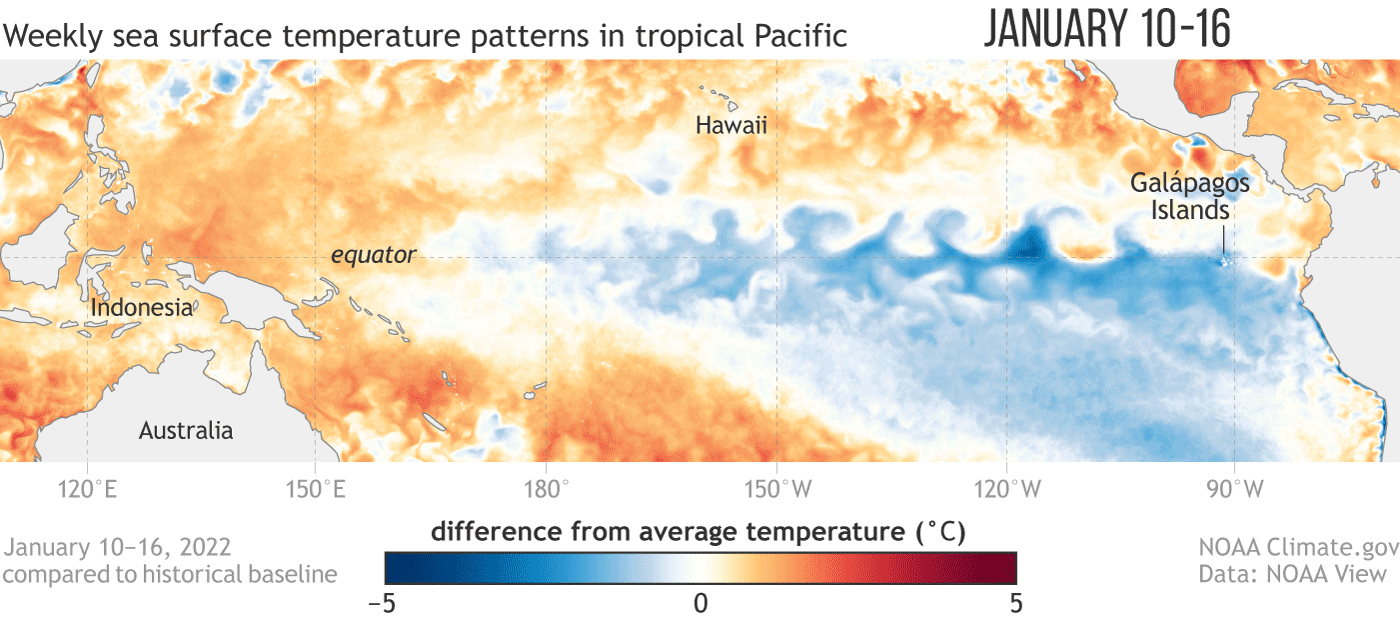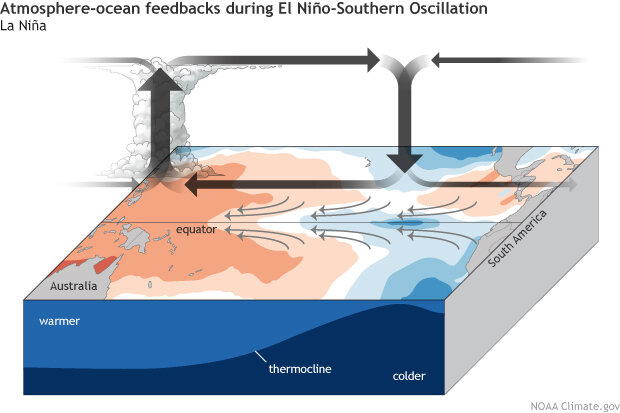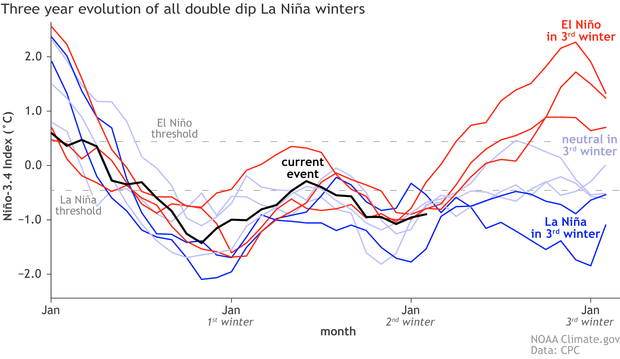March 2022 La Niña update: three-bean salad
Three-bean salads are a blend of sweet-sour tastiness, implying all good things come in threes. Well, depending on your opinion of La Niña, maybe not all good things, as La Niña—the cool phase of the El Niño-Southern Oscillation climate pattern—reasserted itself in the tropical Pacific this past month with some of the strongest atmosphere-ocean coupling of our double-dip La Niñas so far (winters of 2020-21 and 2021-22). La Niña is now favored to continue into the Northern Hemisphere summer 2022, with nearly equal chances of ENSO-neutral or La Niña thereafter. Is a La Niña three-peat in the offing?
Three-dimensional
Back up, La Niña strengthened in February? It did, despite the fact that sea surface temperatures in the key monitoring region of the tropical Pacific, the Niño-3.4 region, appear to have bottomed out in December, with a monthly value of -1.1°C (ERSSTv5 data set). Since then, the monthly values have warmed slightly, though February 2022 remained chilly at -0.9 °C. However, the February average smoothed out some notable variability: the weekly average Niño-3.4 index was -0.6 °C at the beginning of February and then decreased to -1.1 °C in the past week. Quite a dive!
Sea surface temperatures in the tropical Pacific Ocean from mid-January through February 2022 compared to the long-term average. East of the International Dateline (180˚), waters remained cooler than average, a sign of La Niña. Graphic by Climate.gov, based on data from NOAA’s Environmental Visualization Lab. Description of historical baseline period here.
Confused by all the numbers for presumably the same Niño-3.4 sea surface temperature index? Don’t be-- averages for shorter time spans can fluctuate around a lot more than longer averaging periods. This is the difference between weather and climate. Day-to-day or week-to-week weather can change a lot relative to monthly and longer seasonal climate averages, which do not vary as much. Even as the weekly and monthly values have jumped around, the Oceanic Niño Index (ONI), NOAA’s official measure of ENSO, has remained constant at -1.0°C for the third, overlapping season in a row.
One of the major challenges in ENSO prediction is trying to untangle meaningful seasonal swings in the tropical climate from the shorter-term noise of tropical weather. In February, along with cooling off of sea surface temperatures, we saw a stronger Pacific Walker circulation: a strengthening of trade winds along the surface of the equator (blowing from east-to-west), stronger winds in the upper tropical atmosphere (that blow from west to east), significant drying over the Date Line, and increased rainfall anomalies over the Maritime Continent. All of these features are consistent with a healthy La Niña.
During La Niña, the surface trade winds (small gray arrows) blow more strongly than normal, piling up warm surface water in the western Pacific and drawing up deep, cool water in the eastern Pacific. Over the warm waters, the air becomes more buoyant (upward thick arrow), and rainfall increases. Over the cool waters, it is less buoyant, favoring subsidence (downward gray arrow) and less rainfall. These feedbacks between ocean and atmosphere strengthen the La Niña event. Climate.gov schematic by Emily Eng and inspired by NOAA PMEL.
In fact, by some of our atmospheric measures—the Equatorial Southern Oscillation Index and Central Pacific Outgoing Longwave Radiation index (a measure of equatorial rainfall)—we saw some of the largest monthly values dating back to the start of the first La Niña event in the autumn of 2020! The Pacific Walker circulation was clearly juiced up in the past month and is probably why we saw weekly Niño-3.4 sea surface temperatures take a tumble.
With that said, one month doesn’t make an entire season, and it may have been a short-term swerve on the road to the dissipation of La Niña, as it typically does, through the spring and summer. It’s enough to have at least slowed down La Niña’s exit from the global climate stage, but does it portend more meaningful change going forward? We’ll get back to that later.
Three-legged race
What does the continuation of La Niña mean for impacts during the March-May season over the contiguous United States? As regular blog readers know, the two biggest drivers of seasonal climate outlooks are ENSO and climate trends. The images below show the average March-May temperature and precipitation patterns we’d expect based on the combination of historical La Niña patterns and recent (10-15 year) climate trends.
March-May average temperature (top) and precipitation (bottom) compared to the long-term average for the combination of historical La Niña events and climate trends. Data is based on the CPC ENSO composites and modified by Climate.gov.
As one might expect, NOAA CPC’s official seasonal outlooks for March-May 2022 resemble the patterns above with some exceptions. In general, above-average temperatures are favored over a large part of the contiguous U.S., with the exception of the northwestern U.S., where below-average temperatures are more likely. Above-median precipitation is expected over the northwestern U.S. and the Ohio and Tennessee valleys. Below-median precipitation is favored over most of the southern U.S., extending northward into Utah, Colorado, and parts of the western Great Plains (footnote #1).
In addition to these potential temperature and precipitation anomalies, it is also worth checking out a previous article by Mike Tippett and Chiara Lepore on ENSO and Tornadoes. During La Niña, springtime severe weather can be more active in parts of the southern/southeastern United States (though not a guarantee as John Allen explained to us after the 2020-21 La Niña).
Three’s a crowd
Despite a few forecast models suggesting otherwise, below-average sea surface temperature patterns are likely to weaken across the tropical Pacific as we go through the spring, but it’s still an open question how much they will weaken. Will they weaken enough to eventually return to ENSO-neutral (near average conditions across the tropical Pacific)? And when would that happen?
This month the crystal ball became blurrier, with a 54% chance that La Niña persists into June-August 2022. And, after that, it’s pretty much a split between ENSO-neutral and La Niña through the fall, with neither outcome exceeding a 50% probability (and El Niño still has a 10-15% chance!). Thus, reading between the lines, odds for a La Niña three-peat have gone up (Emily first blogged about this possibility in November 2021), but nowhere near certainty. Keep in mind, the accuracy of ENSO forecasts made this time of year are, well…not so great.
Also, La Niña three-peats (triple dips?) are very rare—only two exist in our more reliable historical record going back to 1950 and both occurred after major El Niño events, which our current event did not. The time evolution of the Niño-3.4 index for the two La Niña three-peats is featured in the darker blue lines in the image below. It is also interesting that out of the eight double-dip La Niñas in our historical record, three ended up evolving into an El Niño for the third winter (red lines) and the remaining three ended up on the cooler side, close to La Niña thresholds, but were ultimately classified as ENSO-neutral winters.
Three-year history of sea surface temperatures in the Niño-3.4 region of the tropical Pacific for 8 previous double-dip La Niña events. The color of the line indicates the state of ENSO for the third winter (red: El Niño, darker blue: La Niña, lighter blue: neutral). The black line shows the current event. Monthly Niño-3.4 index is from CPC using ERSSTv5. Time series comparison was created by Michelle L’Heureux, and modified by Climate.gov.
To get to a third consecutive La Niña winter we would need to see ongoing, enhanced easterly trade winds and, also, the replenishment of below-average temperature “fuel” in the subsurface equatorial Pacific Ocean. In February, at least, we saw some trends in this direction.
So, is this two steps forward, one step back? Or three steps forward? Stay tuned next month when Emily returns from vacation. If we’re lucky maybe she’ll include some pretty tropical photos. Maybe three of them.




Comments
Incessant rains
Here in Armenia, Colombia the rain is awful, about 25 days a month minimum. Usually less than an hour but intense. Landslides are starting to kill people and block roads. Stil, the coffee bushes managed to flower and are now ripe with Arabica berries. The clouds slowly drift in from the west, try to cross the high central range and then with adiabatic cooling, cloud water vapor condenses rapidly as it lifts. And then we get hammered.
Sorry to hear about all of…
Sorry to hear about all of the rain and landslides. La Ninas typically mean cool and wet conditions for the northern half of Colombia during the summer, and cooler conditions along the Pacific coast. Armenia is somewhat in between those two areas so it is hard to tell.
North America - La Nina or El Nino for late 2023?
Good afternoon, everyone...
I am doing research for 2.25 yr Exploration of the North American Continent, starting in August-September of 2023. The backbone of the Odyssey is the National Park system in the US & Canada. I got to thinking about the possible weather and Climate, particularly of the South West & West. I am from the North East. Here, we've been getting a LOT of rain. Not snow. Rain. It feels as if it is becoming very much like a Sub-Tropical zone than ever before. So, this has me wondering what will be going on in the South West & West in Autumn of 2023 and into Spring-Summer of 2024. I know there has been and continues to be severe Drought and many National Parks have been devastated by Wild Fires. I've read the article and enjoyed it. I will be following this blog going forward.
So, typically at what point do you feel a high level of certainty that Autumn will yield a La Nina, ENSO-neutral or El Nino event trend? And am I right in understanding that even if we get a La Nina in late 2022, she will most likely dissipate before Summer 2023 and then, hopefully we are in for a ENSO-neutral event for the reminder of 2023 and well into 2024?
Thanks for your input. I appreciate your time. I am curious to have some good idea of what kind of Climate....weather experience I will be having as I travel through the Lower States btw Autumn 2023 and into mid-2024.
Respectfully,
Callileah Rizzuto
j.cal.rizzuto@hotmail.com
Hi Callileah, Wow! Sounds…
Hi Callileah,
Wow! Sounds like quite a trip. We're still in what's known as the Spring Predictability Barrier, a time where our forecast skill can be lower than other months.
Forecasts made in May-June will likely show more clarity for Autumn.
Either way, your instincts are right. La Ninas typically do return to neutral conditions by the next summer.
La Nina
Ahh... Thank you for the reponse. Didn't see it until now. So, perhaps in the next week or so you'll know more about whether it'll be a three-peat... From where I am, the weather has been very mild and not quite so wet as last year. I think in the North East, we will have a mild Summer and somewhat drier than recent few years. Cooler and Drier is what I'm seeing so far and hoping for as well. Anyway. I will check back periodically to see how things are progressing. Take care!
Hi Callileah, The latest…
Hi Callileah,
The latest ENSO Outlook does favor La Nina sticking around the rest of 2022. The forecast will get more confident as we move through the summer.
La Nina
Was interested to know if La Niña was ending in March as they typically do. Distressed to read the prediction of a threepeat. However, it’s now mid April and it appears the storm door has opened for California. Fingers crossed!!
Re: La Niña
The forecast for April will be out later this morning. Stay tuned!
No More La Nina's
In the Great Lakes region in particular, the Midwest and mid south in general, we have the exact opposite problem as out west. We are overwhelmed and sick and tired of years storminess, excessive rain and snow and exceptional cold. La Nina's generally make our crappy climate even crappier.
fascinating weather
Michelle, you write so even a lay person can kinda-sorta understand why we in the Pacific Northwest are experiencing so many changes. Also, just curious, are you any relation to a Pat L'Heureux I knew in Seattle in the '60s? Wishing...Much Joy, Carol A Sund
Pagination
Add new comment